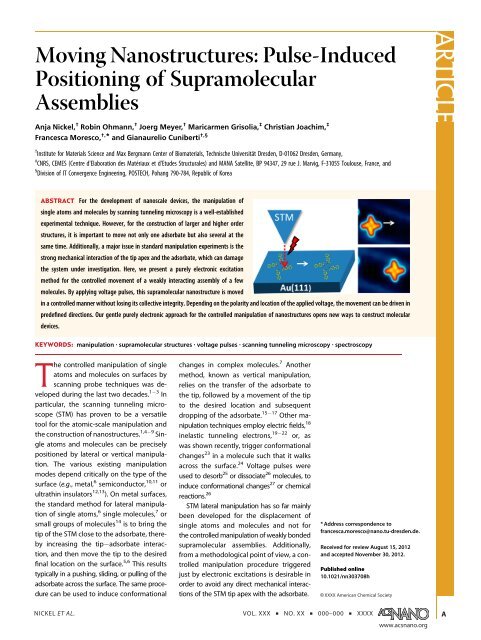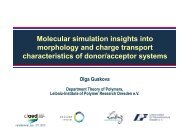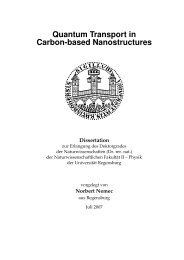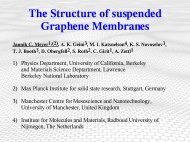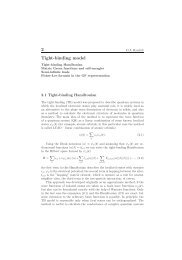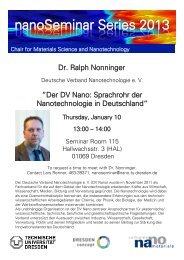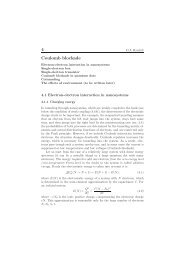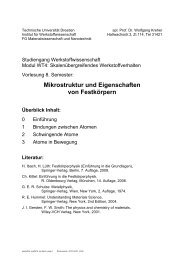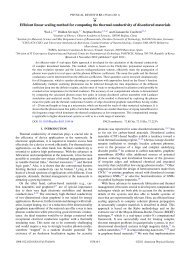for personal use only - Technische Universität Dresden
for personal use only - Technische Universität Dresden
for personal use only - Technische Universität Dresden
You also want an ePaper? Increase the reach of your titles
YUMPU automatically turns print PDFs into web optimized ePapers that Google loves.
Moving Nanostructures: Pulse-Induced<br />
Positioning of Supramolecular<br />
Assemblies<br />
Anja Nickel, † Robin Ohmann, † Joerg Meyer, † Maricarmen Grisolia, ‡ Christian Joachim, ‡<br />
Francesca Moresco, †,* and Gianaurelio Cuniberti †,§<br />
† Institute <strong>for</strong> Materials Science and Max Bergmann Center of Biomaterials, <strong>Technische</strong> <strong>Universität</strong> <strong>Dresden</strong>, D-01062 <strong>Dresden</strong>, Germany,<br />
‡ CNRS, CEMES (Centre d'Elaboration des Matériaux et d'Etudes Structurales) and MANA Satellite, BP 94347, 29 rue J. Marvig, F-31055 Toulo<strong>use</strong>, France, and<br />
§ Division of IT Convergence Engineering, POSTECH, Pohang 790-784, Republic of Korea<br />
ABSTRACT For the development of nanoscale devices, the manipulation of<br />
single atoms and molecules by scanning tunneling microscopy is a well-established<br />
experimental technique. However, <strong>for</strong> the construction of larger and higher order<br />
structures, it is important to move not <strong>only</strong> one adsorbate but also several at the<br />
same time. Additionally, a major issue in standard manipulation experiments is the<br />
strong mechanical interaction of the tip apex and the adsorbate, which can damage<br />
the system under investigation. Here, we present a purely electronic excitation<br />
method <strong>for</strong> the controlled movement of a weakly interacting assembly of a few<br />
molecules. By applying voltage pulses, this supramolecular nanostructure is moved<br />
in a controlled manner without losing its collective integrity. Depending on the polarity and location of the applied voltage, the movement can be driven in<br />
predefined directions. Our gentle purely electronic approach <strong>for</strong> the controlled manipulation of nanostructures opens new ways to construct molecular<br />
devices.<br />
KEYWORDS: manipulation . supramolecular structures . voltage pulses . scanning tunneling microscopy . spectroscopy<br />
The controlled manipulation of single<br />
atoms and molecules on surfaces by<br />
scanning probe techniques was developed<br />
during the last two decades. 1 3 In<br />
particular, the scanning tunneling microscope<br />
(STM) has proven to be a versatile<br />
tool <strong>for</strong> the atomic-scale manipulation and<br />
the construction of nanostructures. 1,4 9 Single<br />
atoms and molecules can be precisely<br />
positioned by lateral or vertical manipulation.<br />
The various existing manipulation<br />
modes depend critically on the type of the<br />
surface (e.g., metal, 6 semiconductor, 10,11 or<br />
ultrathin insulators 12,13 ). On metal surfaces,<br />
the standard method <strong>for</strong> lateral manipulation<br />
of single atoms, 6 single molecules, 7 or<br />
small groups of molecules 14 is to bring the<br />
tip of the STM close to the adsorbate, thereby<br />
increasing the tip adsorbate interaction,<br />
and then move the tip to the desired<br />
final location on the surface. 5,6 This results<br />
typically in a pushing, sliding, or pulling of the<br />
adsorbate across the surface. The same procedure<br />
can be <strong>use</strong>d to induce con<strong>for</strong>mational<br />
changes in complex molecules. 7 Another<br />
method, known as vertical manipulation,<br />
relies on the transfer of the adsorbate to<br />
the tip, followed by a movement of the tip<br />
to the desired location and subsequent<br />
dropping of the adsorbate. 15 17 Other manipulation<br />
techniques employ electric fields, 18<br />
inelastic tunneling electrons, 19 22 or, as<br />
was shown recently, trigger con<strong>for</strong>mational<br />
changes 23 in a molecule such that it walks<br />
across the surface. 24 Voltage pulses were<br />
<strong>use</strong>d to desorb 25 or dissociate 26 molecules, to<br />
induce con<strong>for</strong>mational changes 27 or chemical<br />
reactions. 26<br />
STM lateral manipulation has so far mainly<br />
been developed <strong>for</strong> the displacement of<br />
single atoms and molecules and not <strong>for</strong><br />
the controlled manipulation of weakly bonded<br />
supramolecular assemblies. Additionally,<br />
from a methodological point of view, a controlled<br />
manipulation procedure triggered<br />
just by electronic excitations is desirable in<br />
order to avoid any direct mechanical interactions<br />
of the STM tip apex with the adsorbate.<br />
* Address correspondence to<br />
francesca.moresco@nano.tu-dresden.de.<br />
Received <strong>for</strong> review August 15, 2012<br />
and accepted November 30, 2012.<br />
Published online<br />
10.1021/nn303708h<br />
C XXXX American Chemical Society<br />
NICKEL ET AL. VOL. XXX ’ NO. XX ’ 000–000 ’ XXXX<br />
www.acsnano.org<br />
ARTICLE<br />
A
Figure 1. (a) Molecular structure of 4-acetylbiphenyl (ABP)<br />
(λ and δ chirality). (b) STM topography image of selfassembled<br />
tetramers of ABP on Au(111) (λ and δ chiral<br />
windmill motif). Image size: 38.4 69.3 Å 2 , bias = 1V,I =<br />
2.9 nA. (c) Calculated STM image with the optimized geometry<br />
superimposed. The dashed lines symbolize the intermolecular<br />
hydrogen bonds.<br />
In this article, we show <strong>for</strong> the first time the controlled<br />
manipulation of a supramolecular structure<br />
induced by voltage pulses. By applying voltage pulses<br />
on one selected molecule of the structure, we can<br />
move a supramolecular assembly to a chosen position<br />
on the surface without destroying it.<br />
RESULTS AND DISCUSSION<br />
Characterization of Supramolecular Structures. Figure 1a<br />
shows the 4-Acetylbiphenyl (ABP) molecule <strong>use</strong>d in this<br />
study. It is composed of two phenyl rings and an acetyl<br />
group. On Au(111), the ABP molecules self-assemble<br />
into small weakly bonded supramolecular structures.<br />
Single molecules adsorb at defects and step edges and<br />
cannot be moved away by manipulation.<br />
In Figure 1b, a STM topography image of a supramolecular<br />
ABP tetramer (ABP4) is shown. The ABP<br />
molecules are here organized in a windmill nanostructure.<br />
These windmills are present on the surface in two<br />
mirror symmetric <strong>for</strong>ms as a consequence of the<br />
prochiral nature of the single molecules. A calculated<br />
constant current image of the windmill is presented in<br />
Figure 1c. The calculated geometry confirms the hydrogenbond-like<br />
stabilization of the windmill nanostructure 28,29<br />
and shows a bond length of 3.1 Å. The hydrogen bonds are<br />
indicated by dashed lines in the image. The proposed<br />
structure agrees well with the distances in the windmill<br />
structure determined experimentally from the STM images.<br />
Nanoscale Manipulation. Attempts to move the windmills<br />
using the conventional lateral manipulation<br />
technique 5,6 resulted in a destruction of the supramolecular<br />
nanostructure and the separation of its ABP<br />
components. In order to move the individual windmills,<br />
we applied voltage pulses on top of or close to<br />
one of the ABP molecules of the nanostructure as it<br />
has been done so far on single molecules. 13,22 These<br />
resulted in a controlled collective movement of all ABP<br />
molecules of the chosen windmill at the same time. In<br />
Figure 2, topography images taken be<strong>for</strong>e (top row)<br />
and after (bottom row) the voltage pulse are shown. By<br />
changing the applied voltage, we observe different<br />
types of motions. For negative voltages (Figure 2a), we<br />
predominantly find a collective translational movement<br />
of all molecules of a windmill in the direction<br />
away from the position of the tip. For positive voltages,<br />
we find two possible movement types. Most frequently,<br />
translational movements (Figure 2b) are induced. In<br />
the other cases, we observe a rotation of the windmill<br />
(Figure 2c). For sufficiently high positive voltages, a<br />
total reorganization of the windmill nanostructure<br />
occurs (Figure 2d). It is important to note that <strong>for</strong><br />
positive voltages the direction of the translation is<br />
opposite to that <strong>for</strong> negative voltages; that is, the<br />
center of the supramolecular structure moves toward<br />
the position of the tip. For translational movements, we<br />
typically observe lateral jumps of the windmill of 3 Å,<br />
corresponding to the surface lattice constant of<br />
Au(111). Rotational movements are mainly observed at<br />
positive voltage pulses (in more than 40% of the cases<br />
in contrast to less than 5% at negative voltages) with<br />
rotational angles of 15° (33%) or 30° (66%) in the clockwise<br />
or counterclockwise direction. Be<strong>for</strong>e manipulation,<br />
the windmills are adsorbed with different angles on<br />
the Au(111) surface, showing that energetically equivalent<br />
adsorption sites exist apart from symmetry considerations.<br />
Note that the rotation is possible on the<br />
open surface even without any geometrical constraints<br />
such as a surrounding cavity. 30 Given that the windmill<br />
nanostructures are chiral, we investigated if there is a<br />
rotational preference. However, out of the 200 measured<br />
rotational events, no significant preference <strong>for</strong><br />
one or the other rotation direction was observed. If<br />
there is a preferential rotation direction due to the<br />
chirality of the molecules, as suggested by a recent<br />
work on a single chiral molecular rotor, 31 it will be<br />
rather small. From our measurements, we can give an<br />
upper limit <strong>for</strong> rotation directionality of about 5%. This<br />
confirms that molecule surface chirality is <strong>only</strong> a<br />
necessary condition <strong>for</strong> unidirectional rotation of an<br />
adsorbate. One also needs to filter the random timedependent<br />
fluctuations of the tunneling current and<br />
synchronize with intramolecular time-dependent processes<br />
necessary <strong>for</strong> the rotation to occur in a specific<br />
direction. 32<br />
NICKEL ET AL. VOL. XXX ’ NO. XX ’ 000–000 ’ XXXX<br />
www.acsnano.org<br />
ARTICLE<br />
B
Figure 2. STM topography images of self-assembled ABP on Au(111) taken be<strong>for</strong>e (top row) and after (bottom row) applying<br />
a voltage pulse at the position indicated by the black cross. A negative voltage pulse leads in the majority of cases to<br />
translation (a), whereas a positive voltage pulse leads either to translation (b) or rotation (c) or, <strong>for</strong> sufficiently high voltages,<br />
reorganization of the supramolecular structure (d). Note that the direction of translation is opposite <strong>for</strong> negative and positive<br />
voltages. The white dashed lines are a guide <strong>for</strong> the eyes, and the gray crosses indicate the position of the tip where the<br />
voltage pulse was applied. Image parameters: (a) bias = 0.1 V; (b d) þ0.1 V, I = 50 pA; size 50 50 Å 2 . The color scale is the<br />
same as in Figure 1b. Manipulation parameters: (a) bias = 2.3 V, I = 1.7 nA, t = 20 s; (b) 2.1 V, 3 nA, 10 s; (c) 2.5 V, 0.5 nA, 10 s; (d)<br />
2.7 V, 0.25 nA, 10 s.<br />
Figure 3. Controlled lateral manipulation using consecutive voltage pulses. (a) Total traveling length after six pulses is 36 Å.<br />
The brighter appearance of the right molecule of the windmill in the final position is due to the influence of the reconstruction<br />
lines of the Au(111) surface. At the bottom, the intermediate positions of the windmill after each pulse are shown. (b)<br />
Construction of a novel nanostructure by bringing two windmills together. The molecular aggregate on the bottom serves as<br />
reference <strong>for</strong> the movement of the two windmills. The herringbone reconstruction of the Au(111) surface does not limit the<br />
motion. Manipulation parameters: 2.3 V, 1.7 nA, 10 s. Image sizes: (a) 68 80 Å 2 ,(b)125 73 Å 2 . The color scale is the same as<br />
in Figure 1b.<br />
We have also explored how our manipulation<br />
method can be <strong>use</strong>d to reproducibly move a windmill<br />
nanostructure over large distances. To do so, voltage<br />
pulses were applied consecutively to the windmill<br />
along a predetermined line on the surface. In Figure 3a,<br />
such a manipulation procedure is shown. The left<br />
image shows the initial and the right image the final<br />
position of the windmill after applying a regular series<br />
of voltage pulses. The windmill follows the position of<br />
the tip stepwise along the predetermined line. At the<br />
bottom, the intermediate positions after each pulse are<br />
presented. Importantly, by selecting the molecule to<br />
which the voltage pulse is applied, the direction of the<br />
manipulation can be chosen. Intact windmills can be<br />
controllably moved to defined positions on the surface.<br />
This can be seen in Figure 3b. By moving two windmills<br />
to a desired position, a new nanostructure is built.<br />
Moreover, this example shows that the Au(111) surface<br />
reconstruction does not affect the windmill motion.<br />
Notice that such highly controlled surface positioning<br />
does not require the complex intramolecular mechanical<br />
mechanisms described <strong>for</strong> single-molecule machines. 24<br />
Statistical Analysis. In order to understand the described<br />
manipulation events, we have systematically<br />
analyzed the tip height traces taken during the time<br />
interval of the voltage pulses in constant current mode.<br />
NICKEL ET AL. VOL. XXX ’ NO. XX ’ 000–000 ’ XXXX<br />
www.acsnano.org<br />
ARTICLE<br />
C
Figure 4. Statistical analysis of the voltage pulses: (a) tip<br />
height measured as a function of time during a positive and<br />
negative voltage pulse on a supramolecular structure. (Top)<br />
Bias = þ2.6 V, I = 0.25 nA. (Bottom) Bias = 2.3 V, I = 3 nA; texc<br />
is the time needed to excite an event. (b) Inverse of the<br />
lifetime (i.e., rate) as a function of current plotted in double<br />
logarithmic scale. Bias voltage: 1.8 V. Measurements at<br />
other voltages show the same dependence. (c) Quantum<br />
yield as a function of bias voltage. (d) dI/dV spectra taken on<br />
top of the supramolecular structure (black) and an off<br />
spectrum taken on the bare Au(111) surface (gray). The<br />
inset shows STM images taken at 0.1 V (left) and 2.2 V (right)<br />
(the black cross indicates the position of the tip during the<br />
spectrum).<br />
Two representative examples of such traces, one <strong>for</strong><br />
the positive voltage and one <strong>for</strong> the negative voltage,<br />
are shown in Figure 4a. A jump in the trace indicates a<br />
sudden change in the conductance at the position of<br />
the tip. For positive voltages, we usually see an increase<br />
in tip height (i.e., increase in conductance), whereas <strong>for</strong><br />
negative voltages, a decrease in tip height (i.e., decrease<br />
in the conductance) <strong>for</strong> the first jump is observed.<br />
This agrees with the observation that <strong>for</strong><br />
Figure 5. Choosing the direction of motion by positioning<br />
the tip at a specific molecule of the supramolecular structure.<br />
The position of the tip during the voltage pulse is<br />
indicated by the colored crosses. The different directions<br />
are visualized by the corresponding colored arrows. To<br />
follow the motion of the structure, its center is represented<br />
by a white circle. The colored circles denote the previous<br />
position of the structure in this sequence of images. Manipulation<br />
parameters: 2.6 V, 0.25 nA, 10 s. Image sizes:<br />
98.2 56.1 Å 2 . The color scale is the same as in Figure 1b.<br />
positive voltages the structure moves toward the tip,<br />
whereas <strong>for</strong> negative voltages, the windmill center<br />
moves away from the tip. After the first jump, more<br />
jumps can occur. From the time it takes <strong>for</strong> the first<br />
jump to occur, we deduced the rate as well as the<br />
quantum yield of the event, that is, the probability by<br />
which a movement is triggered. Plotting the rate, which is<br />
the inverse of the average time it takes until the first jump,<br />
as a function of current, we find a linear dependence<br />
indicating a one-electron inelastic process (Figure 4b).<br />
The quantum yield, calculated via e/Iτ, where e is<br />
the elementary charge, I the current, and τ the average<br />
time of excitation, is shown in Figure 4c as a function of<br />
the applied bias voltage. It is evident that the behavior<br />
<strong>for</strong> positive and negative voltages differs. The threshold<br />
voltage to excite an event is much lower <strong>for</strong><br />
negative than <strong>for</strong> positive voltages, where values<br />
above 2 V need to be applied to trigger an event. For<br />
positive voltage pulses, the quantum yield shows a<br />
maximum value at about 2.5 V, whereas <strong>for</strong> larger<br />
voltages, a reorganization of the windmill structure<br />
takes place (Figure 2d).<br />
Electronic Structure. To measure the electronic structure,<br />
we have recorded the STM tunnel junction dI/dV<br />
spectrum over an ABP4 windmill at the same position<br />
where the voltage pulse has been applied <strong>for</strong> manipulation.<br />
For positive voltages, a well-resolved resonance<br />
at about 2.5 V is observed (see Figure 4d)<br />
which can be assigned to the lowest electronic excited<br />
state of the ABP adsorbate. 33 For negative voltages, the<br />
spectrum appears relatively flat. Nevertheless, a broad<br />
and weak resonance at about 2.2 V can be distinguished<br />
in the spectrum. For positive voltages, the<br />
energy onset position of the observed resonance<br />
exactly corresponds to the measured quantum yield<br />
(see Figure 4c), indicating the presence of an inelastic<br />
input channel on the windmill. For negative voltages,<br />
the energy onset begins already at 0.8 V, and beca<strong>use</strong><br />
of the broadness of the resonance, also in this case, the<br />
increase of the quantum yield can be explained by the<br />
electronic resonance. Such localized inelastic excitations<br />
on just one ABP molecule of the windmill are<br />
NICKEL ET AL. VOL. XXX ’ NO. XX ’ 000–000 ’ XXXX<br />
www.acsnano.org<br />
ARTICLE<br />
D
enough <strong>for</strong> the complete supramolecular windmill<br />
nanostructure to translate or to rotate without any<br />
internal apparent structural change.<br />
Once a threshold voltage has been reached, where<br />
tunneling in molecular resonances is possible, the<br />
supramolecular structure can be moved. For voltages<br />
exceeding 2.5 V, the windmill nanostructure is getting<br />
destroyed. In this case, some hydrogen bonds are<br />
broken and a new noncovalently bonded network is<br />
<strong>for</strong>med (see Figure 2d), which differs from the selfassembled<br />
arrangement. Occasionally, we observe<br />
that this reorganization can be reversed by additional<br />
voltage pulses, recovering the original windmill configuration.<br />
Notably, the structural chiral fingerprint<br />
remains in the new structures. For voltages between<br />
2.5 V and the lowest measured negative value of 3.0 V,<br />
the strength of the hydrogen bonds between the ABP<br />
molecules in a windmill is large enough to keep the<br />
nanostructure intact during its excitation and its concerted<br />
motion (translation, rotation). From the statistical<br />
analysis of the time series of the voltage pulses, we<br />
conclude that the process is driven by the inelastic<br />
tunneling of a single electron. The quantum yield is in<br />
good agreement with the electronic structure, confirming<br />
an inelastic input channel.<br />
Directionality. Now we turn to the observed directionality<br />
of the movement which varies with the<br />
polarity and the location of the tip on the structure.<br />
As already discussed, the movement direction depends<br />
first of all on the polarity of the voltage pulse.<br />
If the voltage pulse is positive, the center of the windmill<br />
will move under the tip while the center of the<br />
supramolecular structure will move away from the tip<br />
at negative voltage pulses. This attractive or repulsive<br />
interaction can be <strong>use</strong>d to move the whole structure in<br />
a chosen direction by carefully choosing the position of<br />
the tip on the structure. Let us consider <strong>for</strong> simplicity<br />
the case of a positive voltage pulse. If we place the tip<br />
over the center of the structure and apply a voltage<br />
pulse, there will be no translational movement. If we<br />
apply the same voltage pulse by positioning the tip<br />
over one molecule in an off-center position, it results in<br />
an asymmetric geometry. The center of the assembly<br />
will be attracted by the tip and will move parallel to the<br />
chosen molecule in the direction of the tip. This means<br />
that, by choosing the molecule of the structure on<br />
which we apply the pulse, we can choose the direction<br />
of the movement of the whole structure. An example of<br />
directed manipulation is shown in Figure 5. The directions<br />
METHODS<br />
4-Acetylbiphenyl (ABP) molecules were studied on the Au-<br />
(111) surface with a custom-built low-temperature STM (5 K)<br />
under ultrahigh vacuum conditions (
or low currents (25 pA) were <strong>use</strong>d to ensure that no manipulation<br />
happens during scanning.<br />
For manipulation, the STM tip is precisely positioned on a windmill<br />
and a voltage pulse between tip and sample is applied. During<br />
the pulse, the feedback loop is kept closed and the tip height is<br />
recorded. A jump in the tip height indicates a manipulation event.<br />
Differential conductance spectra were measured using lock-in<br />
detection with a modulation frequency of 833 Hz and a modulation<br />
amplitude of 20 mV. This is a common value <strong>for</strong> tunneling<br />
spectroscopy measurements on molecules, where resonances are<br />
normally weak in intensity due to the low current <strong>use</strong>d and<br />
relatively broad in energy. To ensure the recording of a stable<br />
spectrum, the measurements have been done under closed<br />
feedback-loop conditions with a low set-point current (25 pA).<br />
The exact adsorption con<strong>for</strong>mation of a windmill structure<br />
was obtained by calculating the STM image of an ABP4 supramolecule<br />
on the Au(111) surface after its optimization using the<br />
ASEDþ semiempirical molecular mechanics technique, which is<br />
well adapted <strong>for</strong> such large supramolecular adsorbates. 35 Constant<br />
current images of the optimized geometry were calculated<br />
using ESQC (electron-scattering quantum chemistry). 36<br />
Conflict of Interest: The authors declare no competing<br />
financial interest.<br />
Acknowledgment. This work was funded by the ICT-FET<br />
Integrated Project AtMol, the European Union (ERDF) and the<br />
Free State of Saxony via the ESF Project 080942409 InnovaSens,<br />
the ESF Project 100087859 ENano, and TP A2 (“MolFunc”) of the<br />
cluster of excellence “European Center <strong>for</strong> Emerging Materials<br />
and Processes <strong>Dresden</strong>” (ECEMP). We gratefully acknowledge<br />
support from the German Excellence Initiative via the Cluster of<br />
Excellence EXC 1056 “Center <strong>for</strong> Advancing Electronics <strong>Dresden</strong> 00<br />
(cfAED). The authors thank Thomas Brumme, Cormac Toher,<br />
Dmitry Ryndyk, and André Gourdon <strong>for</strong> fruitful discussions.<br />
REFERENCES AND NOTES<br />
1. Eigler, D. M.; Schweizer, E. K. Positioning Single Atoms with<br />
a Scanning Tunneling Microscope. Nature 1990, 344, 524–<br />
526.<br />
2. Custance, O.; Perez, R.; Morita, S. Atomic Force Microscopy<br />
as a Tool <strong>for</strong> Atom Manipulation. Nat. Nanotechnol. 2009,<br />
4, 803–810.<br />
3. Moore, A. M.; Weiss, P. S. Functional and Spectroscopic<br />
Measurements with Scanning Tunneling Microscopy.<br />
Annu. Rev. Anal. Chem. 2008, 1, 857–882.<br />
4. Stroscio, J. A.; Eigler, D. M. Atomic and Molecular Manipulation<br />
with the Scanning Tunneling Microscope. Science<br />
1991, 254, 1319–1326.<br />
5. Jung, T. A.; Schlittler, R. R.; Gimzewski, J. K.; Tang, H.;<br />
Joachim, C. Controlled Room-Temperature Positioning of<br />
Individual Molecules: Molecular Flexure and Motion.<br />
Science 1996, 271, 181–184.<br />
6. Bartels, L.; Meyer, G.; Rieder, K.-H. Basic Steps of Lateral<br />
Manipulation of Single Atoms and Diatomic Clusters with<br />
a Scanning Tunneling Microscope Tip. Phys. Rev. Lett.<br />
1997, 79, 697–701.<br />
7. Moresco, F. Manipulation of Large Molecules by Low-<br />
Temperature STM: Model Systems <strong>for</strong> Molecular Electronics.<br />
Phys. Rep. 2004, 399, 175–225.<br />
8. Hla, S.-W. Scanning Tunneling Microscopy Single Atom/<br />
Molecule Manipulation and Its Application to Nanoscience<br />
and Technology. J. Vac. Sci. Technol., B 2005, 23,1351–1360.<br />
9. Stroscio, J. A.; Tavazza, F.; Crain, J. N.; Celotta, R. J.; Chaka,<br />
A. M. Electronically Induced Atom Motion in Engineered<br />
CoCun Nanostructures. Science 2006, 313, 948–951.<br />
10. Keeling, D. L.; Humphry, M. J.; Fawcett, R. H. J.; Beton, P. H.;<br />
Hobbs, C.; Kantorovich, L. Bond Breaking Coupled with<br />
Translation in Rolling of Covalently Bound Molecules. Phys.<br />
Rev. Lett. 2005, 94, 145104.<br />
11. Lastapis, M.; Martin, M.; Riedel, D.; Hellner, L.; Comtet, G.;<br />
Dujardin, G. Picometer-Scale Electronic Control of Molecular<br />
Dynamics Inside a Single Molecule. Science 2005, 308,<br />
1000–1003.<br />
12. Repp, J.; Meyer, G.; Paavilainen, S.; Olsson, F. E.; Persson, M.<br />
Imaging Bond Formation between a Gold Atom and Pentacene<br />
on an Insulating Surface. Science 2006, 312,1196–1199.<br />
13. Swart, I.; Sonnleitner, T.; Niederführ, J.; Repp, J. Controlled<br />
Lateral Manipulation of Molecules on Insulating Films by<br />
STM. Nano Lett. 2012, 12, 1070–1074.<br />
14. Böhringer, M.; Morgenstern, K.; Schneider, W.-D.; Berndt, R.<br />
Separation of a Racemic Mixture of Two Dimensional<br />
Molecular Clusters by Scanning Tunneling Microscopy.<br />
Angew. Chem., Int. Ed. 1999, 38, 821–823.<br />
15. Eigler, D. M.; Lutz, C. P.; Rudge, W. E. An Atomic Switch<br />
Realized with the Scanning Tunneling Microscope. Nature<br />
1991, 352, 600–603.<br />
16. Bartels, L.; Meyer, G.; Rieder, K.-H. Controlled Vertical<br />
Manipulation of Single CO Molecules with the Scanning<br />
Tunneling Microscope: A Route to Chemical Contrast.<br />
Appl. Phys. Lett. 1997, 71, 213–215.<br />
17. Lagoute, J.; Kanisawa, K.; Fölsch, S. Manipulation and<br />
Adsorption-Site Mapping of Single Pentacene Molecules<br />
on Cu(111). Phys. Rev. B 2004, 70, 245415.<br />
18. Xu, Y.-Q.; Zhang, J.; Yuan, B.-K.; Deng, K.; Yang, R.; Qiu, X.-H.<br />
Electric Field Assisted Hopping of tert-Butylamine on<br />
Cu(111) Surface. Acta Phys. Chim. Sin. 2010, 26, 2686–2690.<br />
19. Stipe, B. C.; Rezaei, M. A.; Ho, W. Inducing and Viewing the<br />
Rotational Motion of a Single Molecule. Science 1998, 279,<br />
1907–1909.<br />
20. Ohmann, R.; Vitali, L.; Kern, K. Actuated Transitory Metal-<br />
Ligand Bond as Tunable Electromechanical Switch. Nano<br />
Lett. 2010, 10, 2995–3000.<br />
21. Kim, H. W.; Han, M.; Shin, H.-J.; Lim, S.; Oh, Y.; Tamada, K.;<br />
Hara, M.; Kim, Y.; Kawai, M.; Kuk, Y. Control of Molecular<br />
Rotors by Selection of Anchoring Sites. Phys. Rev. Lett.<br />
2011, 106, 146101.<br />
22. Ohara, M.; Kim, Y.; Kawai, M. Electric Field Response of a<br />
Vibrationally Excited Molecule in an STM Junction. Phys.<br />
Rev. B 2008, 78, 201405.<br />
23. Gross, L.; Rieder, K.-H.; Moresco, F.; Stojkovic, S. M.; Gourdon,<br />
A.; Joachim, C. Trapping and Moving Metal Atoms with a<br />
Six-Leg Molecule. Nat. Mater. 2005, 4, 892–895.<br />
24. Kudernac, T.; Ruangsupapichat, N.; Parschau, M.; Maciá, B.;<br />
Katsonis, N.; Harutyunyan, S. R.; Ernst, K.-H.; Feringa, B. L.<br />
Electrically Driven Directional Motion of a Four-Wheeled<br />
Molecule on a Metal Surface. Nature 2011, 479, 208–211.<br />
25. Sloan, A. P.; Sakulsermsuk, S.; Palmer, R. E. Nonlocal<br />
Desorption of Chlorobenzene Molecules from the Si(111)-<br />
(7 7) Surface by Charge Injection from the Tip of a<br />
Scanning Tunneling Microscope: Remote Control of Atomic<br />
Manipulation. Phys.Rev.Lett.2010, 105, 048301.<br />
26. Hla, S. W.; Bartels, L.; Meyer, G.; Rieder, K.-H. Inducing All<br />
Steps of a Chemical Reaction with the Scanning Tunneling<br />
Microscope Tip: Towards Single Molecule Engineering.<br />
Phys. Rev. Lett. 2000, 85, 2777–2780.<br />
27. Henzl,J.;Mehlhorn,M.;Gawronski,H.;Rieder,K.H.;Morgenstern,<br />
K. Reversible cis trans Isomerization of a Single Azobenzene<br />
Molecule. Angew. Chem., Int. Ed. 2006, 45, 603–606.<br />
28. Bernstein, J.; Davis, R. E.; Shimoni, L.; Chang, N.-L. Patterns<br />
in Hydrogen Bonding: Functionality and Graph Set Analysis<br />
in Crystals. Angew. Chem., Int. Ed. Engl. 1995, 34,1555–1573.<br />
29. Barth, J. V.; Weckesser, J.; Cai, C.; Günter, P.; Bürgi, L.;<br />
Jeandupeux, O.; Kern, K. Building Supramolecular Nanostructures<br />
at Surfaces by Hydrogen Bonding. Angew.<br />
Chem., Int. Ed. 2000, 39, 1230–1234.<br />
30. Kühne, D.; Klappenberger, F.; Krenner, W.; Klyatskaya, S.;<br />
Rubern, M.; Barth, J. V. Rotational and Constitutional<br />
Dynamics of Caged Supramolecules. Proc. Natl. Acad. Sci.<br />
U.S.A. 2010, 107, 21332–21336.<br />
31. Tierney, H. L.; Murphy, C. J.; Jewell, A. D.; Baber, A. E.; Iski,<br />
E. V.; Khodaverdian, H. Y.; McGuire, A. F.; Klebanov, N.;<br />
Sykes, E. C. H. Experimental Demonstration of a Single-<br />
Molecule Electric Motor. Nat. Nanotechnol. 2011, 6, 625–<br />
629.<br />
32. Astumian, R. D. Thermodynamics and Kinetics of a Brownian<br />
Motor. Science 1997, 276,917–922.<br />
33. Soe, W.-H.; Manzano, C.; De Sarkar, A.; Chandrasekhar, N.;<br />
Joachim, C. Direct Observation of Molecular Orbitals of<br />
NICKEL ET AL. VOL. XXX ’ NO. XX ’ 000–000 ’ XXXX<br />
www.acsnano.org<br />
ARTICLE<br />
F
Pentacene Physisorbed on Au(111) by Scanning Tunneling<br />
Microscope. Phys. Rev. Lett. 2009, 102, 176102.<br />
34. Lauhon, L. J.; Ho, W. Single Molecule Thermal Rotation and<br />
Diffusion: Acetylene on Cu(001). J. Chem. Phys. 1999, 111,<br />
5633–5636.<br />
35. Yu, M.; Kalashnyk, N.; Xu, W.; Barattin, R.; Benjalal, Y.;<br />
Lægsgaard, E.; Stensgaard, I.; Hliwa, M.; Bouju, X.; Gourdon,<br />
A.; et al. Supramolecular Architectures on Surfaces Formed<br />
through Hydrogen Bonding Optimized in Three Dimensions.<br />
ACS Nano 2010, 4, 4097–4109.<br />
36. Sautet, P.; Joachim, C. Calculation of the Benzene on<br />
Rhodium STM Images. Chem. Phys. Lett. 1991, 185,23–30.<br />
NICKEL ET AL. VOL. XXX ’ NO. XX ’ 000–000 ’ XXXX<br />
www.acsnano.org<br />
ARTICLE<br />
G


